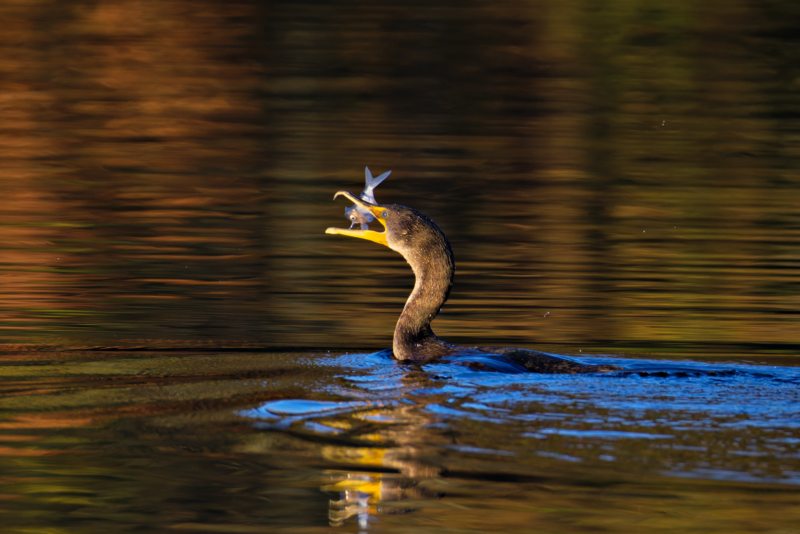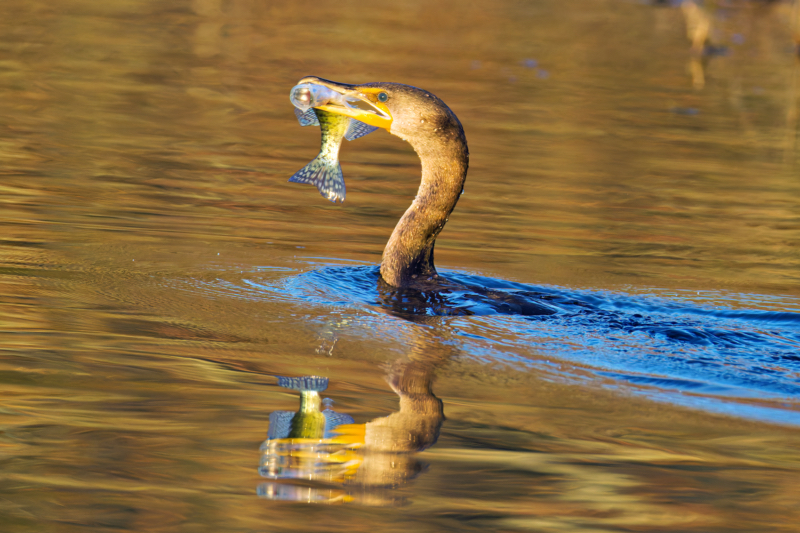A few days ago, I took a short trip to Charleston Lake in Charleston, Arkansas. I like visiting this lake when the cold sets in, as the changing seasons bring a different character to the landscape and wildlife. Winter here consistently brings excellent bird photography opportunities, especially for Bald Eagles. These majestic birds are often seen soaring over the lake, hunting for fish, or perched high in the trees. The lake also has a resident Great Blue Heron that often hunts near the earthen dam. This particular heron has become quite familiar to me, and I always enjoy observing its methodical hunting habits and its patience as it waits for the right moment to strike. Today, however, I want to focus on a Double-crested Cormorant I photographed on December 5th.

Photographing a Double-crested Cormorant with a bright fish in its beak during sunrise is tricky. The contrast between the dark bird and the shiny, reflective fish makes exposure challenging, particularly when dealing with early morning lighting conditions. The warm glow of the sunrise adds complexity to the situation, and balancing these contrasting elements requires careful thought and preparation. Here’s how I handled it:
Exposure Strategy
- Exposure Mode: I used Manual mode for full control over exposure settings, while shooting with auto ISO. This allowed me to adjust the shutter speed and aperture to capture the details I wanted without worrying too much about the changing light conditions of the early morning.
- Metering: I could have used spot metering on the bird’s body or head to avoid overexposing the fish. Spot metering would help in isolating the exposure for the darker parts of the bird while ignoring the bright highlights of the fish. I didn’t do that this time, but it’s an idea for next time, especially in similar high-contrast situations.
- Exposure Compensation: In auto or semi-auto modes, setting a negative exposure compensation (-1 to -2 stops) helps control overexposure of the white fish. In my experience, this can be very useful when dealing with bright, reflective surfaces. I used -1.3 and -0.7 for these shots, and it helped me retain detail in the shiny fish without losing too much detail in the bird’s darker feathers.
Specific Settings
- Shutter Speed: I set the shutter speed to 1/3200 and 2500. With good light, I could keep the ISO down and avoid blur from the bird’s movements while it tossed the fish. The cormorant’s behavior can be unpredictable, and they often shake or flip the fish before swallowing it. Having a fast shutter speed ensured that I captured those brief moments with crisp detail.
- Aperture: My aperture was f/9, as wide as my lens allows at 800mm, to let in more light and create a soft background. The background blur helps isolate the subject, making the bird and its catch the focal point of the image. Given the distance and focal length, f/9 worked well to keep the bird in focus while creating enough separation from the surroundings.
- ISO: I used ISO 2500 and 5000. My goal is always 3200 or below, but I can push to 6400 if needed. At this level, there’s still minimal noise, and the Canon EOS R5 Mark 2 handles it well. Shooting in the early morning means the light is softer but less intense, so balancing the ISO is key to getting the right exposure without introducing too much noise.

Camera Settings Summary For First Photo
- Date: 12/5/24
- Time: 8:41 AM
- Model: Canon EOS R5 Mark 2
- Lens: Canon RF 200-800mm at 800mm
- ISO: 2500
- Aperture: f/9
- Shutter Speed: 1/3200
- Exposure Compensation: -1.3
Techniques
- RAW Format: Shooting in RAW gives me more flexibility to adjust shadows and highlights later. RAW files contain all the data from the sensor, which is particularly helpful when dealing with high-contrast scenes like this one. It allows me to recover details that would be lost if I shot in JPEG.
- Continuous Shooting: I used H+ (20 fps burst mode) to catch the right moment. Cormorants are fast when they’re handling their catch, and I wanted to maximize my chances of capturing the fish flip or the moment it was swallowed. Sometimes I switch to 30 fps, depending on the action, especially if the bird’s movements are particularly dynamic or rapid.
Post-Processing Steps
In post-processing, I often:
- Recover Shadows: Bring out details in the bird’s feathers. The cormorant’s dark plumage can be challenging to expose correctly, especially against a bright background or reflective water. By recovering shadows, I can reveal the intricate feather patterns that add texture and interest to the image.
- Reduce Highlights: Keep the fish from looking blown out. The fish’s bright, reflective surface catches the light easily, and it’s crucial to manage the highlights to retain texture. Reducing highlights ensures that the fish doesn’t become an overexposed white blob, but instead retains its natural texture and shine.
- Adjust White Balance: Enhance the warm tones from the sunrise. The early morning sun casts a beautiful golden glow, and adjusting the white balance helps emphasize that warmth. This adds depth and mood to the image, making it more evocative of the time of day and the atmosphere of the scene.
I also pay close attention to color balance and sharpness during post-processing. Ensuring that the bird’s feathers are sharp and that the colors are true to life helps convey the natural beauty of the scene. When needed, I make minor tweaks to contrast and clarity to help the subject stand out without making the image look overly processed.
These settings and techniques help me capture a balanced shot, showing detail in both the cormorant and the bright fish, while emphasizing the warm morning light. Charleston Lake never disappoints, especially in winter, and this encounter with the cormorant was a perfect reminder of why I keep coming back. The interplay of light, water, and wildlife always provides unique challenges and rewards that make each trip worthwhile. There’s something about the quiet winter mornings, the mist rising off the lake, and the sight of these incredible birds that keeps me hooked. Every outing is an opportunity to learn and refine my techniques, and I’m already looking forward to the next visit.

Very informative, Steve.